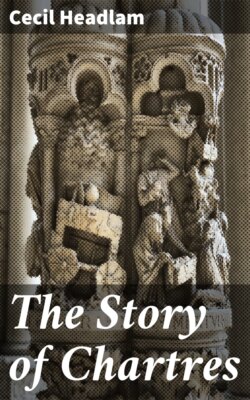Читать книгу The Story of Chartres - Cecil Headlam - Страница 8
На сайте Литреса книга снята с продажи.
CHAPTER II
Saints and Barbarians
ОглавлениеTable of Contents
THE early Christians of Chartres were scattered and their churches destroyed during the final persecution under Diocletian. When, therefore, the disciples of S. Denis, S. Chéron and S. Martin came preaching the Gospel through the valley of the Loire, they found but few faithful among the descendants of those who had been converted by the first missionaries. The evangelisation of the Province by S. Martin, the great Bishop of Tours, was commemorated in the title of the church, ‘S. Martin rendant la vie,’ in reference to one of his miracles, and in that of the Monastery S. Martin-au-Val, as also in the window in the clerestory of the nave of the Cathedral (north) and of the choir. Soldier, hermit, bishop and saint, he established the monasteries of Gaul. Two thousand of his disciples followed him to the grave, and his eloquent historian, Sulpicius Severus, challenges the desert of Thebais to produce, in a more favourable climate, a champion of equal virtue. S. Chéron, after completing his work at Chartres, turned his steps towards Paris, but was assassinated on his way at a place since named S. Chéron-du-Chemin. His martyrdom is represented in a bas-relief of the south porch of the Cathedral.
Then Castor, Bishop of Chartres, profiting by the protection of Constantine, built a second basilica, larger than the first, erecting upon the old site a chapel to the ‘Virgin who shall bear a son,’ and, above it, the main church and the principal altar.
Meanwhile the Roman Empire in Gaul was tottering to its fall. That confederacy known as the Franks, which had been formed of the unconquered tribes that dwelt about the Lower Rhine and the Weser, had overrun Spain and Mauritania, and had been flung back from Gaul by the brilliant efforts of the Emperor Probus. Again reduced by Julian, they remained for some time loyal allies of the Empire. But under Clodion, the first of the long-haired kings of the Merovingian dynasty whose name and actions are mentioned in authentic history, they advanced as far as the Somme, and established a Gallic kingdom between that river and the Rhine. On the death of Clodion, his two sons quarrelled over their inheritance; one of them obtained the protection of Rome, the other allied himself with Attila. For the King of the Huns eagerly embraced an alliance which facilitated the passage of the Rhine and justified the invasion of Gaul.
Gargoyle on South Arch
Chartres seems to have escaped as by a miracle the murderous attack of the Huns and Franks. She owed perhaps to the obscurity of her position the immunity which Paris owed to the prayers of S. Geneviève. But Orléans was besieged and defended successfully by Anianus, a bishop of primitive sanctity and consummate prudence, until the arrival of the Roman and Gothic armies compelled Attila to withdraw his innumerable host of marauders, and at length to give battle and suffer defeat in the plains of Châlons. (451 A.D.)
